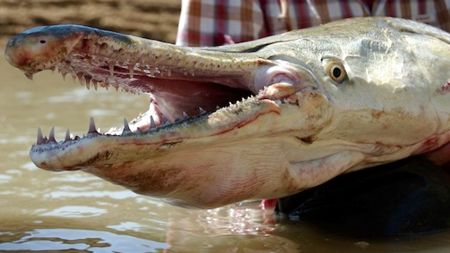by Larry
June, 2018Garpike, Monster Fish, Gator Gar, or Dinosaur - What's In a Name?"A rose by any other name," we are told, "would smell as sweet." But what of a specimen that has more about it of beast than beauty? For a long while, the humble alligator gar (Atractosteus spatula), commonly known to frequent many backwaters of TX, AR, and LA, was considered variously a trash fish, a monster, an aggressive attacker of swimmers and fishermen, and an efficient consumer of more sought after sport fish species, like white bass (or sand bass), rapidly depleting their numbers. As with many stories about things that seem a little fearful or menacing, it turns out gar have an undeservedly bad rap. First, the range of the creature: alligator gar actually live throughout much of the southeast U.S., as far west as OK and TX, plus as far north as the Mississippi, Ohio, and Missouri river basins. To the south, they can be found in drainages well into Mexico. Because gar in general have been around since the days of dinosaurs and indeed look like and are among the more primitive types of fish, they can be mistaken for dinosaurs themselves.
Less enlightened policies prevailed for several decades. In many places, only dead alligator gar were regarded as good ones. Special electrical devices were used with official sanction to lure and kill them. Game and fish department boats would carry the charge equipment and try to jolt the bottom dwelling creatures through the water with 200 volts. A program of trying to eradicate alligator gar had been promoted based on several myths. Here are some facts:
Recognizing that the species is actually good for a more natural ecology, U.S. states where they are found are limiting their hunting or fishing. In the Lone Star State, some bow hunting and angler fishing are allowed, and there are a number of enthusiasts keen on these type adventures. The largest alligator gar successfully caught in TX to date was an eight-foot, 279 pound "monster fish" from Liberty County, near Houston, TX. Prior to the current sanctions against much fishing in other states, though, bigger gar catches were recorded, including one that weighed 327 pounds in waters near Vicksburg, MS. In the 1930s, a giant alligator gar was caught by bow hunting in the Saint Francis River, AR. It weighed 350 pounds. Particularly because of the mushrooming numbers of invasive species, destructive to native fish, such as Asian carp which are more readily a prey of alligator gar, the latter fish is once again regarded as a valued part of the ecosystem. However, understanding that there may still be misconceptions about alligator gar, such that they are being killed senselessly, lately there have been legitimate moves toward associating them more with dinosaurs, as the latter are regarded as cool, and so helping folks think of alligator gar as especially worthy of conservation. If in the process we inappropriately call them "dinosaur fish," what is the real harm? |
